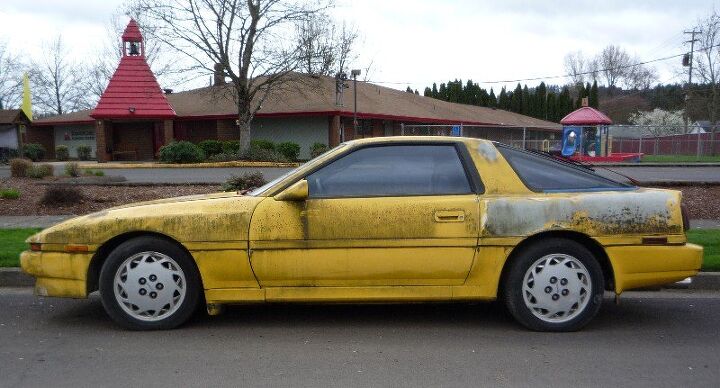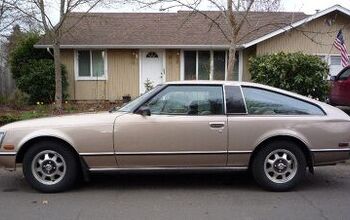Curbside Classic: 1987 Toyota Supra Mark III

Toyota’s failure to crack the US pony car market over the long term is one of its few major stumbles. When I found the pristine Celica Supra Mk I, and then ran across this sad looking and likely abandoned/stolen Mark III, I knew it was fated for me to do a three-parter on the first three generations of Toyota’s ill-fated pony car challenger. It took me a while to find the Mark II, but now we’re at the point of pulling the whole thread together. I’m far from an expert on the Mark III, so please add to the limited body of knowledge that I can muster or fake. One thing is clear: Toyota’s trajectory with the Supra led to a dead end, and that path started early on, perhaps right from the get-go. And the Mark III clearly marked the beginning of the end.
The regular Celica’s mission in life was relatively easier, at least for longer than the Supra’s. The Celica was to the Mustang and Camaro what the Corona/Corolla was to the Impala/Malibu and the like: smaller, lighter, cheaper alternatives when that was in demand. But despite a strong start and a fairly good run, even the Celica’s mission didn’t work out in the end, due to the Mustang’s incomparable dollar/horsepower value, and the return of interest in V8 powered pony cars.
But the Supra had an even harder road to hoe. On the pricey side from the beginning, it get ever more so. Its positioning in the market was problematic. The Mark II had enough high-tech features that were not so common at the time (DOHC six, IRS, etc.) and superb build quality that it could just pull off its super-Mustang price, even if much of its performance envelope was eclipsed by the crude but effective ‘Stang.
The Mark III was a substantial notch up in terms of chassis sophistication (double-wishbone suspension), performance (turbo version), and a general move upscale. Based on Toyota’s Soarer, the Mark III also got the cream of Toyota’s engine stable at the time, the 3.0 Liter 7M-GE four-vale inline six. The normally aspirated version made 200 hp; the (mild) turbo: 230 hp. Quite a healthy jump from the 160 hp of the Mark II, but the Mustang GT was making 225 at the time, for thousands less.
The niche for high-tech JDM-style sports tourers was small and too crowded, and eventually collapsed. That didn’t come to full fruition until the time of the Mark IV, but the sales numbers for the III were shrinking. It shows in the dearth of Supras of this vintage on the streets here. For quite a while, this one was the only one I came across. I’ve seen one or two since, but they’re pretty elusive. And though you may be turned off by the condition of this yellow buzz-bomb, I find it strangely appealing. The contrast of the yellow paint and the dirt or whatever has stained it is photographically compelling. I strongly suspect that this car was stolen and abandoned here, since there were no houses nearby. And it’s also attracted the attention of a prospective next owner, from the tattered note on the windshield that asks: “Is this car for sale?” You wouldn’t likely see that on an old tattered Mustang. The Supra may be gone, but it’s anything but forgotten.

More by Paul Niedermeyer
Latest Car Reviews
Read moreLatest Product Reviews
Read moreRecent Comments
- Tassos Jong-iL Here in North Korea we are lucky to have any tires.
- Drnoose Tim, perhaps you should prepare for a conversation like that BEFORE you go on. The reality is, range and charging is everything, and you know that. Better luck next time!
- Buickman burn that oil!
- Jkross22 Meant to ask.... what's the best oil to use in a popcorn popper? I've been wanting to try peanut oil, but can't find anything smaller than the huge container at smart n final.
- Ajla A union fight? How retro 😎





































Comments
Join the conversation
In 1991 Toyota Australia raced two Supra Turbos to a 1-2 finish in the Bathurst 12-Hour as part of the last phases of their marketing effort before being withdrawn from sale. In Japan they were raced in a "Group A" spec (500 made, all black), and also in more modified formats with the 3S-GTE engine (in place of the 7M-GTE). Toyota Team Europe even rallied them for a year in 1988 (?? - my memory is a bit vague on that).
Toyota's biggest mistake, the one I most blame for the demise of the Supra, was not offering the top end engines to the US market right away. The 7MGTE 3.0L turbo was only Toyota's top of the line engine till 1989'. After that the JZ engine family was introduced and came in the Supra in Japan and it was fantastically better; more powerful and more reliable (it didn't have the head gasket or oiling system problems the 7M engines had). I think if they had introduced the 280hp 1JZGTE to the US market the MKIII would have remained viable till it was replaced in 1993 with the MKIV (that coincidentally DID get a turbocharged JZ engine, the 2JZGTE). Starting in 89' the poor 7M powered 230hp Turbo Supra was up against the 300ZX TT, 3000GT VR4, NSX, and even Toyota's own MR2 turbo. The Supra being the least powerful Japanese flagship car doomed it, along with a few upset owners who had already had head gasket problems at low mileages. Look at the sales numbers from 86.5' to 88' vs 89' to 92' and you can see what I mean.